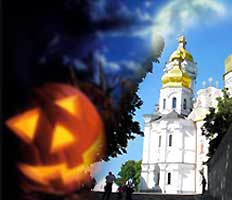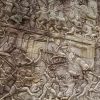most of us are either newly Orthodox or newly aware of our Orthodoxy,
we must carefully examine every aspect of our involvement in the world
– its activities, festivals, associations, and societies – to be
certain whether or not these involvements are compatible with our Holy
Orthodox Faith. This difficult task can lead to some pain when we
realize that we cannot take part in some popular organizations and
activities.
Most of our schools, local community
organizations, and entertainments in television, radio and the press
will share in and capitalize upon the festival of Halloween. But
Orthodox Christians cannot participate in this event at any level. The
simple issue – Fidelity to God and the Holy Orthodox Christian Faith.
Halloween has its roots in paganism, and it continues as a form of
idolatry to worship Satan, the angel of death. As we know, the very
foundation of our Holy Church is build upon the blood of martyrs who
refused despite painful penalties to worship, venerate, or pay
obeisance in any way to the idols who are Satan”s angels. Because of
the faithfulness, obedience, and self-sacrifice of the Holy Martyrs,
God poured out abundant Grace upon His Holy Church, whose numbers
increased daily. The persecution did not stem the spread of faith.
Differing from the world”s values, humble faithfulness and obedience to
God were the very strength of their life in Christ, Who gave them true
spiritual peace, love and joy, and participation in the miraculous
workings of His Holy Spirit. Therefore, the Holy Church calls us to
faithfulness by our turning away from falsehood toward Truth and
eternal life.
We can stay away from the pagan festival of
Halloween if we understand the spiritual danger and history of this
anti-Christian feast.
 The feast of Halloween began in
The feast of Halloween began in
pre-Christian times among the Celtic peoples who lived more than 2,000
years ago in what is no United Kingdom, Ireland, and northern France.
These pagan peoples believed that physical life was born from death.
Therefore, they celebrated the beginning of the “new year” in the fall
(on the eve of October 31 and into the day of November 1), when, as
they believed, the season of cold, darkness, decay and death began. The
Celts believed that a certain deity, whom they called Samhain, was the
lord of death. To him they gave honor at their New Year”s festival.
From
an Orthodox Christian point of view, many diabolical beliefs and
practices were associated with this feast, which have endured to this
current time. On the eve of the New Year”s festival, the Druids, who
were the priests of the Celtic cult, instructed their people to
extinguish all hearth fires and lights. On the evening of the festival
they ignited a huge bonfire built from oak branches, which they
believed to be sacred. Upon this fire, they offered burnt sacrifices of
crops, animals, and even human beings to appease and cajole Samhain,
the lord of death. They also believed that Samhain, being pleased by
their faithful offerings, allowed the souls of the dead to return to
homes for a festal visit on this day. This belief led to the ritual
practice of wandering about in the dark dressed in costumes indicating
ghosts, witches, hobgoblins, fairies and demons. The living entered
into fellowship and communion with their dead by this ritual act of
imitation, through costume and the wandering about in the darkness,
even as the souls of the dead were believed to wander.
The
dialogue of “trick-or-treat” is integral to Halloween beliefs and
practices. The souls of the dead had – by Celtic tradition – entered
into the world of darkness, decay, and death, and made total communion
with and submission to Samhain, the lord of death. They bore the
affliction of great hunger on their festal visit. This belief brought
about the practice of begging as another Celtic ritual imitation of the
activities of the souls of the dead on their festal visit. The
implication was that any souls of the dead and their imitators who are
not appeased with “treats”, i.e. offerings, will provoke the wrath of
Samhain, whose angels and servants (the souls and human imitators)
could retaliate through a system of “tricks” or curses.
The
Orthodox Christian must understand that taking part in these practices
at any level is an idolatrous betrayal of our God and our Holy Faith.
For if we imitate the dead by dressing up in or wandering about in the
dark, or by begging with them, then we have willfully sought fellowship
with the dead, whose Lord is not a Celtic Samhain, but is Satan the
Evil One, who stands against God. Further, if we submit to the dialogue
of “trick-or-treat,” our offering goes not to innocent children, but
rather to Samhain, the Lord of Death whom they have come to serve as
imitators of the dead, wandering in the darkness.
 We must stay
We must stay
away from other practices associated with Halloween, the eve of the
Celtic New Year festival. The Druid priests used to instruct their
faithful to extinguish their hearth fires and lights and to gather
around the fire of sacrifice to make their offerings and to pay homage
to the Lord of Death. This sacred fire was the fire of the new year, to
be taken home to rekindle lights and hearth fires. The sacred New
Year”s fire developed into the practice of the Jack-o”-lantern (in the
U.S.A. a pumpkin, in older days other vegetables were used), which was
carved in imitation of the dead and used to convey the new light and
fire to the home, where the lantern was left burning throughout the
night. Even the use and display of the Jack-o”-lantern honors the
Samhain, the Celtic god of death. Orthodox Christians cannot share in
this Celtic activity, but must counter the secular customs by instead
burning candles to the Savior, the Most Holy Mother of God, and to all
the Holy Saints.
Divination was also part of this ancient Celtic
festival. After the fire had died out the Druids examined the remains
of the main sacrifices, hoping to foretell the coming years events. The
Halloween festival was the proper night for sorcery, fortune telling,
divination, games of chance, and Satan worship and witchcraft in the
later Middle Ages.
In the strictly Orthodox early Celtic Church,
the holy Fathers tried to counteract this pagan new year festival that
honored the Lord of Death, by establishing the Feast of All Saints on
the same day. (It differs in the East, where the Feast of All Saints is
celebrated on the Sunday following Pentecost). The custom of the Celtic
Church was for the faithful Christians to attend a vigil service and a
morning celebration of the Holy Eucharist. This custom created the term
Halloween. The Old English of All Hallow e”en, i.e., the eve
commemorating all those who were hallowed (sanctified) became Halloween.
The
remaining pagan and therefore anti-Christian people, whose paganism had
become deeply intertwined with the Occult, Satanism and Magic, reacted
to the Church”s attempt to supplant their festival by increased fervor
on this evening. The early medieval Halloween became the supreme feast
of the Occult, a night and day witchcraft, demonism, sorcery and
Satanism of all kinds. Many practices involved desecration and mockery
of Christian practices and beliefs. Costumes of skeletons developed as
a mockery of the Church”s reverence for Holy Relics; Holy things were
stolen, such as crosses and the Reserved Sacrament, and used perversely
in sacrilegious ways. The practice of begging became a system of
persecution to harass Christians who were, by their beliefs, unable to
participate with offerings to those who served the Lord of Death. The
Western Church”s attempt failed, to supplant this pagan festival with
the Feast of All Saints.
The ancient Slavic counterpart to
Halloween in ancient Russia was Navy Dien” (Old Slavonic for the dead
“nav”), which was also called Radunitsa and celebrated in the spring.
To supplant it, the Eastern Church attached this feast to Easter, for
celebration on Tuesday of Saint Thomas” Week (second week after
Easter). The Church also changed the name of the feast into Radonitsa,
from Russian “radost” – joy, of Easter and of the resurrection from the
dead of the whole manhood of Jesus Christ. Gradually Radonitsa yielded
to Easter”s greater importance and became less popular. And many dark
practices from old Russian pagan feasts (Semik, Kupalo, Rusalia and
some aspects of the Maslennitsa) still survived till the beginning of
our century. Now they are gone, but the atheist authorities used to try
to reanimate them. Another “harmless” feast – May 1, proclaimed “the
international worker”s day” is a simple renaming the old satanic feast
of Walpurgis Night (night of April 30 into the day of May 1), the
yearly demonic Sabbath during which all participants united in “a
fellowship of Satan”.
Paganism, idolatry and Satan worship–How
then did things so contradictory to the Holy Orthodox Faith gain
acceptance among Christian people? The answers are spiritual apathy and
listlessness, which are the spiritual roots of atheism and turning away
from God. In society today, one is urged to disregard the spiritual
roots and origins of secular practices when the outward practices or
forms seem ordinary, entertaining, and harmless. The dogma of atheism
underlies many of these practices and forms, denying the existence of
both God and Satan. Practices and forms of obvious pagan and idolatrous
origin are neither harmless nor of little consequence. The Holy Church
stand against them because we are taught by Christ that God stands in
judgment over everything we do and believe, and that our actions are
either for God or against God. Therefore, the customs of Halloween are
not innocent, but are demonic, precisely as their origins prove.
There
are evil spirits. Devils do exist. Christ came into the world so that,
through death, He might destroy him that had the dominion of death,
that is, the Devil (Hebrews 2:14). Christians must see that our
greatest foe is the Evil One who inspires nations and individuals to
sin, and who keeps them from coming to the truth. Until we know that
Satan is our real enemy, we can make little spiritual progress. For our
struggle is not against flesh and blood, but against principalities,
against powers, against the world rulers of the darkness of this age,
against the spiritual hosts of wickedness in the heavenly places
(Ephesians 6:12).
Today we witness a revival of satanist cults
and special satanic ceremonies on Halloween night. Everywhere Satan
reaches out to ensnare more innocent people with spiritualism,
supernatural phenomena, seances, prophesies and all sorts of
demonically inspired works.
Divine Providence ensured that St.
John of Kronstadt, that physician of our souls and bodies, should have
his feast day on the very day of Halloween, a day the world dedicated
to the destroyer, corrupter, and deceiver of humanity. God has provided
us with this powerful counterpoise and weapon against the snares of
Satan, and we should take full advantage of this gift, for truly God is
wonderful in His Saints.
http://stgeorgehermitage.org/halloween.html
















